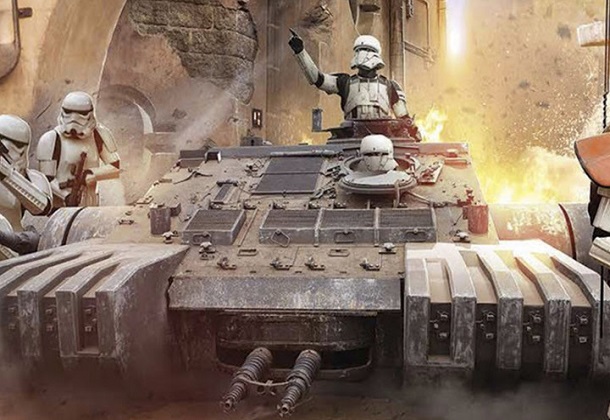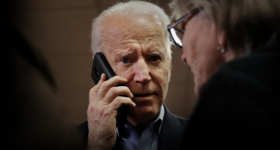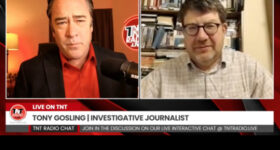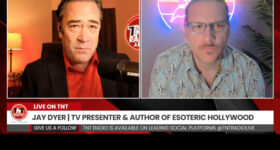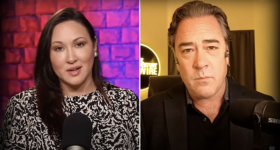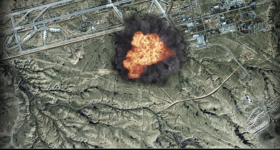 Branko Malić
Branko Malić
21st Century Wire
There’s a widely spread prejudice that George Lucas’ Star Wars trilogy is fundamentally – even exclusively – based on Joseph Campbell’s idea of mono-myth. It is, we are told, primarily a portrait of “a hero’s journey,” embodied in the exploits of Luke Skywalker, starting off on his path to achieve the maturity and spiritual accomplishment in a quite modernized, to the century of self(ish) appropriated, theory of ancient pedagogical method – intended to paint “the veritable image of truth” (Plato) when rational argument fails to express it.
Although Campbell’s influence is duly noted by Lucas and some other leading filmmakers of his generation, my intuition for some time was that there’s something more fundamental and at the same time more mundane to quasi-mythical subtext of Star Wars films.
Namely, as an outside – and quite unfashionably amiable – observer of American mentality, I couldn’t help but notice that American’s almost unilateral fondness of those films has more to do with their own relatively recent history, than to the “archetypes” modern psychology sells us as something original and fundamental to all human beings.
Well, it’s hard not to notice how those blazing turrets of Millenium Falcon, X-Wing fighters scrambling for the attack run and all that individual sacrifice in the name of the Universe of the Free and Galaxy of the Brave astonishingly mirrors the visuals of old WWII propaganda documentaries, featuring B-17 fending off German or Japanese fighters or dive bombers ravaging Imperial Japanese fleet at the battle of Midway.
Moreover, I have to admit that, for my money, Luke and his buddies don’t really resemble Jason and Argonauts. I’d say they are more like typical innocent faced late Seventies kid in kung-fu outfit, accompanied by space cowboy, inarticulate non-Caucasian gentle giant and prom queen in distress with the girl-next-door demeanor.
.
In summation, therefore, I’d say that universal acclaim that Star Wars gets among American people across the political spectrum – from patriots to hard core critics of their own “American Empire” – is rather an expression of subconscious, but quite adamant, national pride.
This is the reason why I find Star Wars: Rogue One a puzzling film. Namely, it is a straightforward, emotionally-laden war movie with an unspoken yet clear message: a praise of suicide in defiance of USA.
We are treated with the universe where a omnipresent Empire is fighting rebels, split into ‘moderates’ and radical (sound familiar?) opposition. The rebels are obligatory multicultural, with recognizable Middle Eastern features in the forefront, and radical factions are introduced in the scene through a blatantly evocative public image of urban warfare in USA, echoing occupied Iraq, or present day Syria:
Hero and her assassin sidekick scour the desert planet’s urban landscape in search for clues of whereabouts of her former mentor, now leader of the Al-Qa … er … radical rebels. The city is obviously a simulacra of stereotypical Middle Eastern locale, which is quickly confirmed when protagonists find themselves in the midst of a terrorist attack by radical Musl… er … rebels on Imperial patrol. The soldiers in their meticulous military attire talking with standard American English and equipped with bulky, not very sci-fi looking, armored vehicle are suddenly attacked from all sides by radicalized “democratic opposition” – collateral damage to civilians is aplenty and one of protagonists has no qualms to shoot one of the freedom fighters in the heat of the moment. The scene is a rehash of standard fare post 9/11 war movie shoot-out, complete with the mosque, dusty town square and dirty looking civilians.
.
The mind boggling thing – with boggling intensifying with each new scene – is the fact that we are presented with the standard Hollywood image format of the attack on American soldiers. Only this time around the spectators are expected to sympathize with the ‘rebel’ assailants. Here, we can begin understand the true power of Hollywood.
Moreover, the Empire is present in this middle of nowhere to extract a valuable resource for its military-industrial complex which obviously makes it the uncontested ruler of the Galaxy. If we assume that movie mirrors the historical reality – or its media image, which is nowadays the same – there’s no other reference then to USA/NATO.
Why is this so? The Empire from three foundational Lucas movies was clearly modeled on Nazi Germany – admittedly accent-free English was used, as not to make it too cheesy – with its geometrical regularity and sharp contrasts of slick uniformity and order. Well this time around, not only visually, but plot-wise as well, we are presented with something completely different; ein Volk, ein Fürher monolith shows a few cracks as both this and previous movie had humanized the villains by making some of the main characters defectors from the Reich. Progressive ebony & ivory homoeroticism from previous installment, where afro-imperial Chelsea Manning develops a relationship with Caucasian ace pilot, has now been morphed into Semitic defector who gets tortured by radical Osama bin Whitaker in his cave compound, before earning his stripes in the rank of moderate rebels. Namely, he returns to his people and, like everyone else in the end, dies a martyr’s death in a suicide attack.
The other clear clue as to the identity of “good guys” is presented with two unemployed samurai like warriors, one of whom is prone to chant the mantra “Allahu Ak… er … I am one with the Force … the Force is with me”. At the end of the movie the other one picks it up too, precisely to work himself into frenzy at the moment when he commences his suicidal last attack to avenge his fallen Shehid comrade. In contrast to previous films, the invocation of Lucas’ dualistic “spiritual” principle of Galaxy this time around is an empty, mechanical chanting of words, not the whisper from the “spiritual guide” or introspective moment – quite like the frenzied, idiotic, unceasing and probably narcotic fueled chanting of ISIL fighters.
So, every possible media image of Middle East is there: democratic opposition to the Empire split into moderate and radical faction, radical leader operating from the cave, people blowing themselves to kingdom come for the glory of Force, clueless high-tech soldiery trying to stop them, not realizing that people determined to die are unstoppable. It’s all so very clear and obvious.
But this makes things all the more mind boggling.
Namely, Star Wars are mainly movies made for Americans. If the previous installments exploited systemically submerged national pride, why would this one promote the suicide in defiance to it?
For roles have changed and rebels are not WWII US Airforce squadron led by UN like council, but an uneasy alliance of derelicts split into factions and united in determination to suicide bomb the hell out of their high-tech, uniformed, adversary. The heroes are not led by all American teenager and space cowboy, but by damaged adolescent girl and professional killer. There’s really no individualism, everybody gets to sacrifice him- or herself; supposedly for “hope”, connecting this prequel to the original Star Wars: New Hope.
Yet I don’t think movies are about words, but moving images. And this set of moving images seems to tell quite a different, ominously hopeless, story.
I adhere to an idea that Western movie industry is a tool for shaping the subconscious mind of the masses. Even more radically, I affirm that blockbuster potential signals that movie contains subliminals that range from consciously inducing the novel forms of fashion to producing synthetic cultural movements.
For example, Matrix movie is the source of most of the contemporary conspiracy culture – it’s lingo, it’s “philosophies” and it’s aims: to go “down the rabbit hole”, take a “red pill”, “break through the matrix”, etc. Moreover, the sophisticated violence of Matrix batch of freedom fighters is directed against the establishment – SWAT teams and police in general – with the convenient excuse that they’re “asleep, therefore potential enemies”.
.
No wonder the movie was so popular since it gave young people opportunity to imagine offing their fellow men simply because they are “asleep” or “sheeple”. It is the perfect foundation for every alienated adolescent’s philosophy, where he can at the same time indulge saintly ideal of salvation through truth and ruthlessness of sociopath. And, of course, we are presented with the paradox of establishment subtly suggesting to viewer that he should attack the establishment itself.
I don’t know what the purpose of Star Wars: Rogue One subtext is, but I cannot help but notice the continuity of this strange nudge to hostility towards one’s own society, already present in the whole range of movies, from Matrix onwards. For what is worth, it definitely seems to be an insidious one and, given the deep influence this line of celluloid software enacts on subconscious mind of American people, I don’t think it’s accidental. And this time around it is obviously not framed to have a happy ending.
***
Author Branko Malić is a Croatian author and owner of Kali Tribune. Branko has a background in classical philosophy and literature. He’s focused on philosophy, media, culture and deep politics analysis.
READ MORE HOLLYWOOD NEWS AT: 21st Century Wire Hollywod Files
SUPPORT OUR WORK BY SUBSCRIBING & BECOMING A MEMBER @21WIRE.TV





